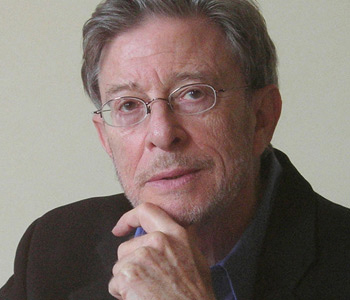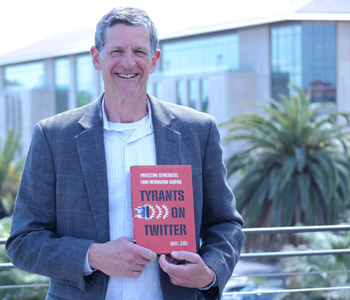Wafaa Bilal and Kari Lydersen
Shoot an Iraqi: Art, Life and Resistance Under the Gun
City Lights
240 pages, 8 1/2 x 6 inches
ISBN 978 0872864917
I live in two worlds. I fled my native Iraq in 1991 during the Gulf War, and after almost two years in horrific refugee camps in Saudi Arabia and Kuwait, I started a new life in the U.S. as an artist and professor. My consciousness and my reality are now split between my current life with all its relative luxuries and mundanities, and my home country, which has continually been torn by war and strife.
The 2004 death of my brother in a U.S. bombing, followed closely by the death of my father, brought this duality into stark relief. I had to do something to address the schism between the conflict zone of my home country and the comfort zone of my new life. I also wanted to provoke dialogue and raise awareness of this schism among the people of my current reality—everyday Americans who largely go about their lives with little awareness of the violence being waged in their names.
So I sequestered myself in a gallery for a month with a robotic paintball gun aimed at me that people could shoot over the internet, 24 hours a day. The project was called Domestic Tension, or informally, Shoot an Iraqi. The experience provoked unexpected and stirring emotional reactions and discussions—within my own mind and also among the tens of thousands of people who ultimately participated in the project.
The book is about this story—my journey from the conflict zone to the comfort zone, and art, and all the gray areas in between.

The 2004 death of my brother in a U.S. bombing, followed closely by the death of my father, brought this duality into stark relief. I had to do something to address the schism between the conflict zone of my home country and the comfort zone of my new life.
For Americans following media coverage of the past two Iraq wars, Saddam Hussein was something of a cliché, a ridiculous megalomaniacal figure whose very existence provided cover for two wars waged for oil and other geopolitical reasons. For me and my peers growing up in Iraq, Saddam Hussein was very much a reality, a man both pathetic and terrifying who defined our daily existence, shaped our routines, determined our futures and invaded our dreams.
Especially for an individualistic, expressive and anti-authoritarian artist like myself, life became a game—but a deadly serious one—of double entendres, hidden meanings, unspoken thoughts, furtive efforts. Most of my childhood and youth were defined by war and violence, from the Iran-Iraq war of the 1980s to the first Gulf War and following uprising, not to mention the violent repression of the regime against its own people. This naturally took a steep toll on my own family; I lost numerous relatives to war and political violence and our daily lives and relationships were determined largely by political realities.
But even so, regular life went on, something that many Americans forget when they see Iraq only as a chronically repressed and war-torn country. There was humor, beauty, love and mischief in my life and the lives of my friends and family. And we lived in a land steeped in history and natural beauty – Babylon. We grew up feeling ourselves in a historical epic, physically connected to the heroism of our Shia martyrs and the winding streets of the ancient city of Kufa.
Shoot an Iraqi is in many ways a universal story of loss, tragedy, guilt and hope. But it is also a story specifically about Iraq, and how the long arc of history and current geopolitical realities in Iraq play out in the life of an ordinary family. Readers will be forced to confront the impact of U.S. aggression and foreign policy in the Middle East, and see first hand the effects on everyday Iraqis of two wars, broken promises and devastating U.S. sanctions.
But I hope that readers will also gain an understanding of Iraq as a whole—through one man’s eyes and experience. My country is about more than just wars; this book is also about ancient legends, cultures that long precede American involvement—indeed, the very history of the United States.
Here in the U.S. we read and watch the news of countless deaths in Iraq and other war-torn countries around the world. We briefly take note of the incidents, sometimes we might even read a name or glance at a photo. But it is rare that we ever visualize the death, the moments that led up to it and follow it, the way it ripples out across families and even down through generations.
I myself had this same experience when my brother Haji was killed in Iraq. It was shattering and at the same time remote. It wasn’t until three years later, in the midst of my Domestic Tension performance art project, that the loss really hit me. Take these excerpts from the book:
I can’t hold it in anymore. In a wave of despair, I realize I truly will never see my father or brother again. I crawl over to the desk behind the paint-splattered plexiglass screen so I can cry without them seeing me. I set my video camera, recording everything, on top of the desk aimed up at my face, determined to document myself even as I am sinking into a black hole of grief. I sob. Tears stream down my face and catch in my beard; my face contorts in pain; small moans like a child’s escape from my twisted lips. I haven’t cried like this since they died. With all the physical and mental exhaustion, I can no longer keep up the barriers that had been holding everything back.
To the camera, I say, “This project has allowed me to deal with things I had avoided for a long time, the loss of my brother and my father, my family, I miss them terribly. I miss home!”
My brother had his entire future in front of him. He was only in his mid-20s, and he had gotten married just a year ago. He was supporting the family with the thriving business he had started with a cousin. They sold gravel and sand from our family land in the dry Sea of Najaf to construction contractors. The Bilal family owned a large tract of land in this ancient sea, now a barren flatland too rocky and parched for farming, abutting the famous Najaf cemetery. Our relatives had refused to give our immediate family our rightful share of the land. Haji was so tough and strong, much more so than me and the other brothers. He walked with a swagger and literally had his gun on his hip at all times. So he confronted a top man in the tribe and convinced him to turn over the land. My family lived in a really rough neighborhood, it made the south side of Chicago look like a picnic. Even before the war, you would see people shot and slaughtered on a regular basis. So you had to be tough to survive there, and Haji was one of the toughest.
Moqtada al Sadr’s headquarters were in Kufa and Najaf. As U.S. troops were advancing toward the city, his Mahdi Army put out a checkpoint of tough guys on the other side of the river to stop them. Al Sadr’s people came to the house and put pressure on Haji to man this checkpoint at the Kufa Bridge. My mother and Ahmed said there’s no way you’re going. But there was a lot of pressure on him to go out and man that checkpoint. He was close with al Sadr’s men, and he didn’t want to appear weak. When I had talked to him on the phone he was using words I could tell would lead to no good, talking about the “invaders” – the U.S. – and how he would resist them. I had told him to stay away from al Sadr’s people, but of course he didn’t listen.

My country is about more than just wars; this book is also about ancient legends, cultures that long precede American involvement—indeed, the very history of the United States.
During and after my Domestic Tension project, the post traumatic stress disorder I had suffered intensely in my early years in the U.S. resurfaced with a vengeance. This is not surprising given the experience of literally being under the gun, confronting the loss of my brother and my father and experiencing the hate and rage—as well as support and care—of viewers and participants. PTSD and its confusing and wide-ranging effects became one of the central themes of my project.
Already PTSD among American soldiers has become a high profile topic and concern, but I know we have only begun to see what will ultimately be a tidal wave of emotional trauma washing back over the U.S. as our troops return home from wars in Iraq, Afghanistan and elsewhere. Given my own experience with PTSD, I am deeply afraid of the consequences for individuals, families and society as a whole.
My Domestic Tension project and my larger story provoke readers, I hope, to not only see the ground-level effects of war abroad, but to see Iraqis and regular Americans as victims and pawns in power plays beyond their individual control. People everywhere need to better understand the impacts and results of such wars and foreign policies. I can only hope that through dialogue and collective action, we can do something.



.jpg)
We don't put paywalls. We don't distract you with ads. We don't sell your data.
Please help to keep this running!